When the Air Force’s new leadership nominees sat at the witness table during their confirmation hearing this summer, the health of the force was foremost on the minds of many members of the Senate Armed Services Committee.
Lawmakers circled through questions for Gen. Norton A. Schwartz, the Chief of Staff nominee, and Michael B. Donley, the presumptive Air Force Secretary, that covered the waterfront from nuclear security to the increased reliance on unmanned aerial vehicles.
But the Senators returned several times to the issues most vexing to the operational Air Force. The one big question appeared to be the one without an immediate solution, short of pouring billions more dollars annually into the Air Force’s budget.
“What is your solution … to get rid of this aging aircraft problem?” asked Sen. James M. Inhofe (R-Okla.)
The Air Force’s aircraft have been flying, on average, for 24 years, representing the oldest fleet in the service’s 61-year history. Some aerial refueling tankers, in particular, date back to the 1950s, posing serious operational and maintenance challenges to an Air Force at war. The effect is real: USAF has seen its breakdown rates and its cost per flying hour each increase by about 17 percent since 9/11.
There is no quick fix in sight.
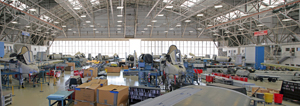 |
A-10 attack aircraft go through repair, maintenance, and refurbishment at the Ogden Air Logistics Center, Hill AFB, Utah. |
In order to merely sustain the fleet’s average age, the Air Force would have to buy about 160 aircraft a year—roughly 50 more than the service typically purchases each year, said Schwartz, who was confirmed 10 days later to be the Air Force’s 19th Chief of Staff.
To drive down that average age, Schwartz said, the Air Force would have to find room in its procurement accounts for a mind-bending 200 new aircraft every year.
But finding the modernization and recapitalization money needed for its fleet of tactical airlifters, bombers, search and rescue helicopters, tankers, and fighters is “going to be a neat trick,” said Donley.
The standing force is wearing out and being replaced at a rate the service considers too slow. Meanwhile, nonstop wartime operations continue to grind down many segments of the force, with war supplemental funds never quite compensating for the accelerating wear and tear.
Seeking Resources
Further compounding the Air Force’s readiness problem was a personnel gamble that turned out to be a bust. USAF had hoped to use manpower savings to help pay for modernization, but the savings never materialized and the Air Force had to win approval to build its end strength back up.
Recognizing the strains of constant deployments, Defense Secretary Robert M. Gates recently announced that he would halt the Air Force’s plan to cut the size of its force from 360,000 to 316,000 personnel. The force will stand, at least for the near term, at an end strength of about 330,000 personnel.
In sum, it was too few people who were too busy. They were operating too small an equipment force that was too old. Not exactly a recipe for improving readiness.
“We need more resources,” said Donley in a measured understatement. But USAF is also dealing with what is known in Washington as a “resource constrained environment,” and Donley (whose confirmation was held up in the Senate at press time) fully understands that.
“I have been in this town for 30 years and we always live in a resource constrained environment,” he continued. “We have to make these trade-offs, and we are not always able to choose and implement the most effective acquisition profile for every program at the same time.”
It is of course true that every aircraft the Air Force owns is aging from the day it rolls off the assembly line. But what is particularly troublesome is that the service has spent the last 17 years on a wartime footing and is now seeing age-related problems accelerating.
“Literally since 1991, since Desert Storm,” Adm. Michael G. Mullen, Chairman of the Joint Chiefs of Staff, told reporters in June, the Air Force has been “pressed very hard in terms of aviation requirements.”
“Part of the discussion that’s been taking place,” Mullen added, “has been how long the Air Force has been flying these airplanes.”
Over the last several years, operational demands on the force have increased as the number of daily missions flown in Iraq and Afghanistan has grown steadily since the initial lull after the early days of the wars.
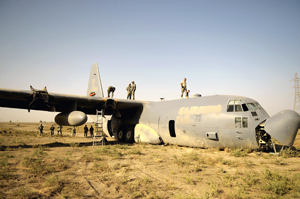 |
Airmen from the 447th Air Expeditionary Group place explosive charges on the wings of a C-130 that crash-landed in Iraq. It was a total loss. |
Perhaps that rising demand is felt nowhere as much as in the airlift community charged with transporting cargo and people through the war zones and around the world.
Indeed, the Air Force broke its record for the largest amount of cargo moved in a single day when it transported 3.92 million pounds of cargo this Feb. 29, according to Combined Forces Air Component Commander statistics provided by US Air Forces Central.
In March, the service moved 82.7 million pounds of cargo and nearly 120,000 passengers—setting two more records for War on Terror airlift operations.
Every month, the Air Force estimates that its airlift operations take between 9,000 and 10,000 people and at least 3,500 vehicles off the dangerous roads of Iraq. Improvised explosive device attacks are now down sharply, but the roads have been peppered with roadside bombs and other threats.
“We’re putting them in C-130s and C-17s,” then Air Force Chief of Staff Gen. T. Michael Moseley told reporters in February. “So, if you can take 3,500 [vehicles] and 9,000 people, at the low end, a month off the road, then that’s some good work.”
But airlift isn’t the only area where the Air Force has seen an uptick in operations. Air strikes, for instance, increased significantly between 2006 and 2007.
According to AFCENT, the total number of close air support and precision strike sorties flown by the US military and coalition members in Operation Iraqi Freedom and Operation Enduring Freedom jumped from 26,195 in 2006 to 33,519 just one year later.
Those figures, which are not broken out to include only USAF missions, are continuing on pace so far this year. By Aug. 4, AFCENT had counted 21,343 precision strike and close air support sorties.
A letup in Air Force effort is unlikely regardless of how many US ground forces stay in Iraq. Gen. John D. W. Corley, chief of Air Combat Command, told reporters earlier this year that he expects the military to leverage its combat advantage in the air well into the future.
“I can envision where we may return to a posture where there’s fewer, if you will, forces on the ground and will continue to take advantage of that asymmetric advantage that you get from air,” Corley said in March.
That could mean airpower via “unmanned aerial systems that possess both intel, surveillance, and reconnaissance capabilities, plus striking, or … manned platforms in concert with some that are on the ground,” he added.
As air operations have increased, there appears to be a corresponding effect on operational costs and failure rates since the outset of operations in Afghanistan and Iraq.
Indeed, between 2001 and 2007, failures on Air Force aircraft—as indicated by the “break rate,” or failure per 100 sorties—have risen by 17 percent, according to the Air Force. (The maintenance community has clearly been pulling its weight, however—maintenance man-hours have remained fairly constant since 2002.)
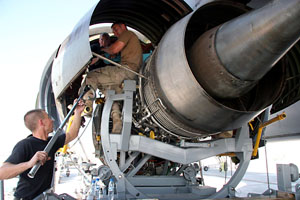 |
SSgt. Kevin Brown, SSgt. Joseph Dodson, and SSgt. Jamie Sherwood (l-r) install a replacement engine on a KC-10 Extender. |
Issues of Priority
During that same period, overall operating cost per flying hour, adjusted for inflation, has risen by approximately the same 17 percent.
The issue, then, becomes one of prioritization of resources across the fleet. Without the extra $20 billion annually the Air Force has said repeatedly that it so desperately needs, where does the force spend its limited dollars?
“We have said that it’s the [next generation] tanker first,” Schwartz said. “That is the appropriate first priority, but I think we have to look across the fleet and dialogue with you, make sure each of the members of the committee appreciates the risks and the opportunities, and then gain consensus on a program for recapitalizing that fleet.”
The heavy reliance on the force’s ancient tanker fleet is clearly a concern to the Air Force leadership. Between 2006 and 2007, AFCENT saw coalition tanker sorties jump 24 percent from 12,787 to 15,875.
By Aug. 4, AFCENT already had counted 10,408 tanker sorties this year.
There has been a similar increase in the amount of fuel offloaded, which has grown from 740 million pounds in 2004 to 946 million pounds last year.
Although those figures include missions flown by allies and other services, the Air Force shoulders the lion’s share of that load in airframes that date back decades.
“We’re driving ’57 tankers into combat today,” said Maj. Gen. Loren M. Reno, commander of Oklahoma City Air Logistics Center, in June. “Our aircraft are old and we need to replace them.”
During the confirmation hearing in July, Sen. John W. Warner (R-Va.), second-ranking member on the Senate Armed Services Committee, likewise expressed concerns about the age and operational stress on the tanker fleet.
“We’re asking an awful lot of those young aviators to, night and day in any place in the world, roll them out, take them down that runway, take them off, hope and pray to come back with a good, safe landing,” Warner said.
The Air Force, however, will have to keep waiting for its overdue new tankers.
In February, the service awarded a $35 billion deal to Northrop Grumman and EADS, the European parent company of Airbus, to build 179 KC-X tankers.
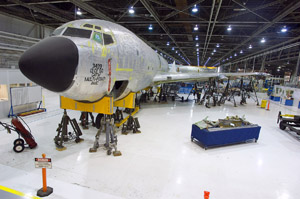 |
A KC-135R is in line for a maintenance overhaul at the Oklahoma City Air Logistics Center, Tinker AFB, Okla. USAF will have to keep waiting for its replacement tanker. |
Infinite Obstacles
But Boeing Co., the losing bidder, successfully protested the award with the Government Accountability Office, sparking a 100-day review. GAO ultimately found that Boeing would have had a “substantial chance” of winning the contract but for several Air Force errors, prompting Defense Secretary Robert M. Gates to reopen the competition.
Senior Pentagon officials had said they hoped the new competition would be wrapped up by the end of the year. But Gates on Sept. 10 terminated the competition, saying the politically sensitive program should be left to the new Administration.
Despite the bureaucratic and administrative hurdles the Pentagon must endure to award a new contract, the sense of urgency on buying new tankers is not lost on Congress, the Pentagon, or the Air Force’s new set of leaders.
“The Air Force needs a new tanker; the joint warfighters need a new tanker,” Donley told the Senators. “This is a critical capability that facilitates the projection of US influence around the globe.”
The Air Force is still meeting its wartime requirements, but the job becomes increasingly difficult over time. Service leaders frequently refer to Air Force readiness as being maintained on the backs of its airmen.
Corley in March told reporters that USAF’s most stressed career fields are civil engineers, intelligence, transportation personnel, and security forces. In those fields, he said, so-called “dwell rates”—or the time spent at home—often are significantly less than the time spent deployed.
“So, is it stressing on our people? Yes, it is,” Corley said. “Has the reduction in terms of overall number of people hurt? Yes, it has.”
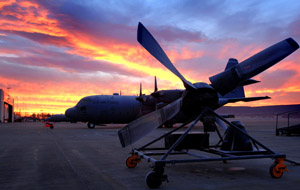 |
The propeller blades for a C-130 Hercules have been wheeled onto the flight line at Ramstein AB, Germany, ready to be installed. |
In addition to deploying troops for its more traditional missions, the Air Force is also sending roughly 6,000 airmen overseas at any given time to assist with traditional ground-force taskings. These “in lieu of” missions, which the Air Force is picking up so that the heavily deployed Army and Marine Corps can concentrate on ground combat operations, include convoy support and prison guard duty.
Gates, who has been harshly critical of the Air Force in many areas, recently praised Air Force personnel for their contributions to the war in Southwest Asia.
“Put simply, without the Air Force’s contribution in the skies and in many cases on the ground, America’s war effort would simply grind to a halt,” Gates said July 24 at Lackland AFB, Tex. “Every soldier and marine in Iraq and Afghanistan is profoundly grateful to have you overhead watching out for them.”
Megan Scully is the defense reporter for National Journal’s CongressDaily in Washington, D.C., and a contributor to National Journal and Government Executive. Her most recent article for Air Force Magazine, “AFSO21 Progress Report,” appeared in the July issue.